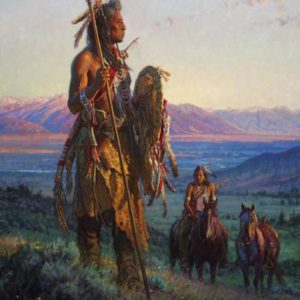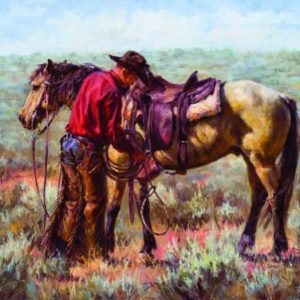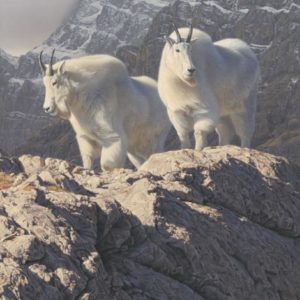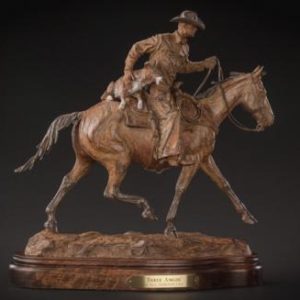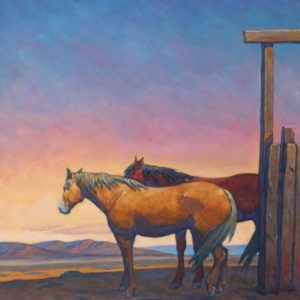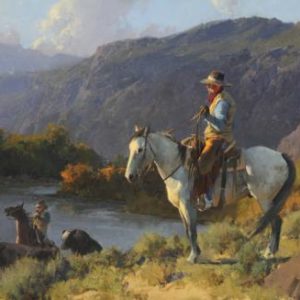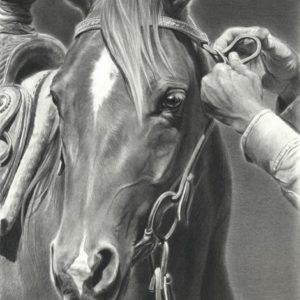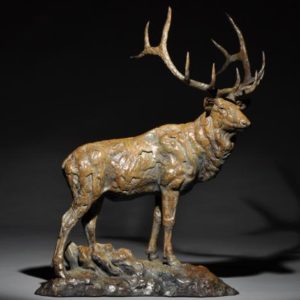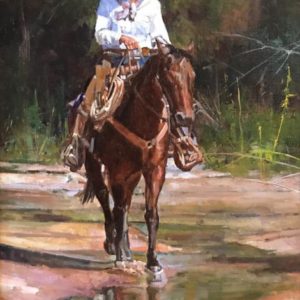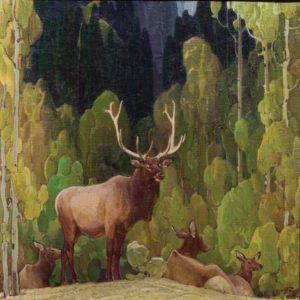Martin Grelle was a very nervous young man when, in 1974, just a year after he graduated from high school, he had his first art show at a gallery and frame shop in Clifton, Texas. “I had no idea what to expect,” he says. “It’s hard to remember, but I probably had, at most, eight or 10 pieces for the show, and we sold almost all of them the first evening. I had a combination of oils, charcoals, and pastels in the show, and the largest piece was probably an oil painting about 24” by 36”. It probably sold for
Read More
Archives for Wildlife
Realism with a Painterly Slant
Shawn Cameron can’t remember when she first began drawing horses. “I never decided I would be a Western artist,” she says. “It was just a natural outcome of my life. I painted or drew horses from—I can’t remember when I started! But from my earliest memory, I drew what I saw, and what I saw was horses and cattle.” A fourth-generation cattle rancher, Cameron grew up among horses, cattle, and working cowboys. She also grew up immersed in the arts. “My mother encouraged it, always,” she says. “She studied art and music herself, and my brother and I had professional
Read More
The Wonder of Wildlife
Hailed as one of the nation’s premier wildlife artists, the path Montana-based painter Daniel Smith traveled in reaching this position of renown has been one of dedication and evolution. Born in Mankato, Minnesota, in 1954, he says he was genetically infused with a love of art and nature thanks to his father, an inveterate outdoorsman, who used his own wood-burning skills to give visual testimony to his inherent love for wildlife. He goes a step further, saying that same gene seems to have been passed on to his son, Adam. “After dabbling with art a bit in high school, at
Read More
A Lifelong Journey
The first sculpture Bill Nebeker cast was of two mountain men. He had been crafting small clay pieces at his kitchen table in the evenings, after working all day with other artists at George Phippen’s Bear Paw Bronze Foundry in Skull Valley, near Nebeker’s home in Prescott, Arizona. “It was pretty crude,” Nebeker admits. But it sold. So did the others he made after it. It wasn’t long before he was making more selling sculptures than he was at the foundry, so he gave up his job and starting sculpting full time: cowboys, mostly, but also Native Americans and wildlife.
Read More
Abstract Impressionism
Perched atop the corrals or catwalks above rodeos, artist Howard Post gets a view that rouses his muse. The patterns of cattle huddled together in the corral, or the linear outline of the fences create a vision that spawns his artistic vision and are a strong focus in the Arizona artist’s paintings. Post, once an avid rodeo participant himself, discovered this birds-eye perspective by accident. To get a better look, he clambered up above the activity and discovered patterns and light that hadn’t been evident from his ground-level participation. The new perspective set his contemporary paintings of cattle, cowboys, rodeo
Read More
In Praise of the Cowboy
Bill Anton traces his fascination with the West back to a trip he took, when he was just 7, with his family to Glacier National Park and the West Coast. “The mountains, the air, the weather were profoundly different from anything I’d known,” says the artist, who grew up in Chicago, Illinois. “I’d never seen anything that was like the American West, and the impression it made on my mind and heart was unmistakable. I’d find a way to be back to stay the minute I was old enough—and I did.” Now living in Prescott, Arizona, Anton has been sharing
Read More
Creating an Interesting Dance
Some nights, Mary Ross Buchholz dreams that she is making art. “Sometimes I wake up and—oh, mercy—I didn’t finish that after all; it was just a dream,” she says in her melodic west Texas drawl. “I eat, sleep, and breathe art.” It’s an apt commentary on Buchholz’s life, a busy but joyous synthesis of ranching, family life, and, of course, art. She and her husband Bob run a good-sized ranch near Eldorado, Texas—population 1,961—and for many years she has balanced her creative endeavors seamlessly with the family business. “Maybe a little bit of our daily ranch life shines through in
Read More
‘My Best Years are Still Ahead’
The first few years after moving to the United States were the lowest in Mick Doellinger’s life. In 2003, he sold his home, his furniture, his taxidermy business, and his studio in Australia to come to America and become a wildlife sculptor. He certainly hadn’t expected it to be easy, but he didn’t realize how lonely it would be. “I had no resources, no family, no safety net,” Doellinger says. “But I knew that, if I wanted to be a full-time sculptor, the United States was where I needed to be.” He also knew that he couldn’t really go home:
Read More
‘I Love What I Am Doing’
Although Tom Dorr ranks among the nation’s most prolific painters of Western art, the Phoenix-based artist, who was born in Chicago, Illinois, and spent his early years in Kansas City, Kansas, had little affinity for subjects west of the Mississippi. That changed, when his father’s employer, AT&T, transferred the family to Colorado Springs, Colorado, in the early 1950s. “I was about 12, when we arrived in Colorado, and by then I had already discovered my love for painting and drawing,” Dorr says. “At that time, there were still a lot of old farms and ranches in the area, so I
Read More
Western Voices: Past and Present
Generations of painters and sculptors make up the fabric of art of the American West. The ongoing influence of artists, reaching back to the 1800s, is evident in the ambitions and efforts of younger artists today and, just as the best artists of old are known by their unique stylistic voices, a new generation strives to develop its own voice and, perhaps, the opportunity to influence those who follow them. Art of the West has been a platform for Western art for the past 30 years, helping us to hear the voices of new generations of artists, along with echoes
Read More
